Page 11 of 426
CAUSPlC
BURNS
SPARK OR ql!,
COULD
FUME
EXPLODE
BATTERY
I F
1 :
f
I
1
These symbols
are important
for you and
your passengers whenever your
vehicle
is
driver.:
DOOR LOCK
UNLOCK
POWER
WINDOW
These symbols
have to do with
your lamps:
I. These symbols i These symbols
are on some of ' are used OR
your controls: wming and
[ indicator lights: i
WEWTkATIMG
FAN
BRAKE
ANTI-LOCK (e)
BRAKES
Here xe some
other symbols
you may see:
SPEAKER
FUEL
ProCarManuals.com
Page 87 of 426

I
LOCK @I: This is the only position from which
YOU can remove the key. This position locks YOU
igition, steering wheel and transaxle. It’s a
theft-deterrent feature.
OFF (C): This position lets YOU turn ofif the engine but
still turn the steering wheel. It doesn’t lock the steering
wrlhee1 like LOCK and it doesn’t send my electrical
power to
the accessories. The instrument panel cluster
will remain powered in OFF to illarminate the gear sWt
indicator. The cluster will also activate the parking brake
fight when the parking brake is set. Use OW if you must
have your vehicle in motion while the engine is
not mnanaing.
RUN (D): This is the position that the switch returns to
after you start YSUP engine and release the switch. This
is &e p~sisi~n for driving. Even when the engine is not
running, you can use RUN to operate your electrical
power accessories anad t~ display some instrument panel
START (E): This position starts your engine. When the
engine
starts, release the key. The ignition switch will
return to RUN for ~a~rrrnal driving.
wdng
lights.
Retained Acces§ory Power
After you turn the ignition off md even remove the key,
you
will still have electrical power to such accessories
as the radio, astroroof ad power windows for up to
10 minutes. Power is shut off if you open a door.
2-21
ProCarManuals.com
Page 90 of 426
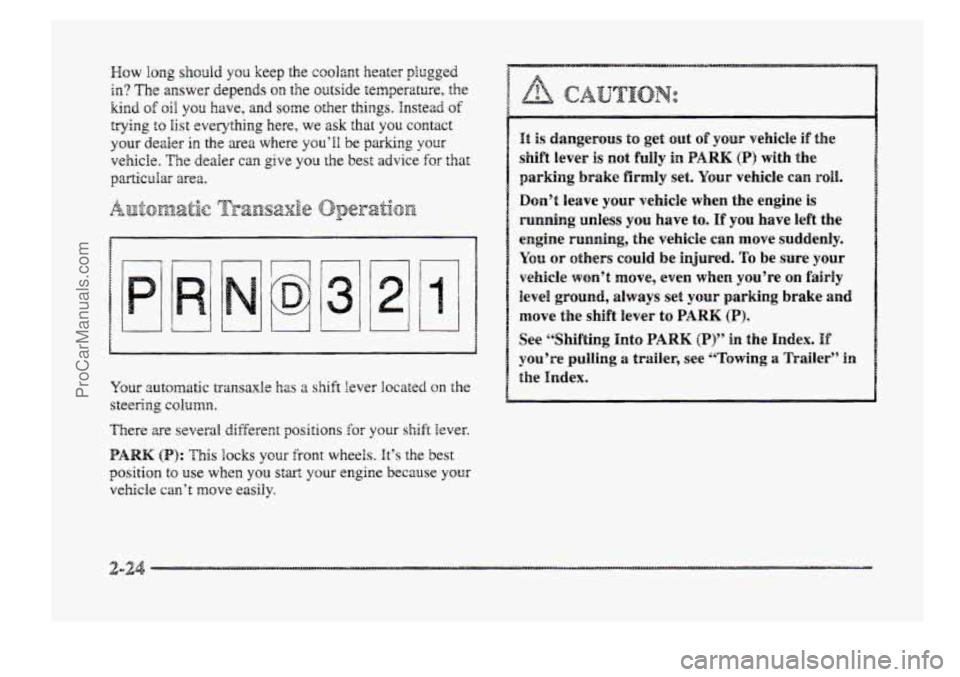
Wow long shodd YOU keep the coolant heater plugged
in? The answer depends on the outside temperature, the
kind of oil you have, and some other things. Instead of
trying t~ list everything here, we ask that you contact
your
dealer in the area where you’ll be parking pur
vehicle. The dealer cm give you the best advice for that
particdar area.
Y0mr automatic transaxle has a shift lever located on the
steering column.
There we several different positions for your shift lever.
PARK (PI: This Bocks your front wheels. It’s the best
position t~ we when YOU start your engine because pl~r
vehicle can’t move easily.
CAUTION:
I& is dangerous to get out of your vehick if the
shift lever is not fully in PARK (P) with the
parking brake firmly set.
Your vehicle can roll.
Don’t leave your vehicle when the engine is
running unless you have to. If you have left the
engine running, the vehicle can move suddenly.
You or others could be injured. TQ be sure your
vehicle won’t move, even when you’re on fairly
level ground, always set
y0w parking brake and
move the shift lever to PARK (P).
See ‘“Shifting Hnt~ PARK (P)” in the Index. If
you’re pulling a trailer, see “Towing a Trailer” in
the Index.
2-24
ProCarManuals.com
Page 91 of 426
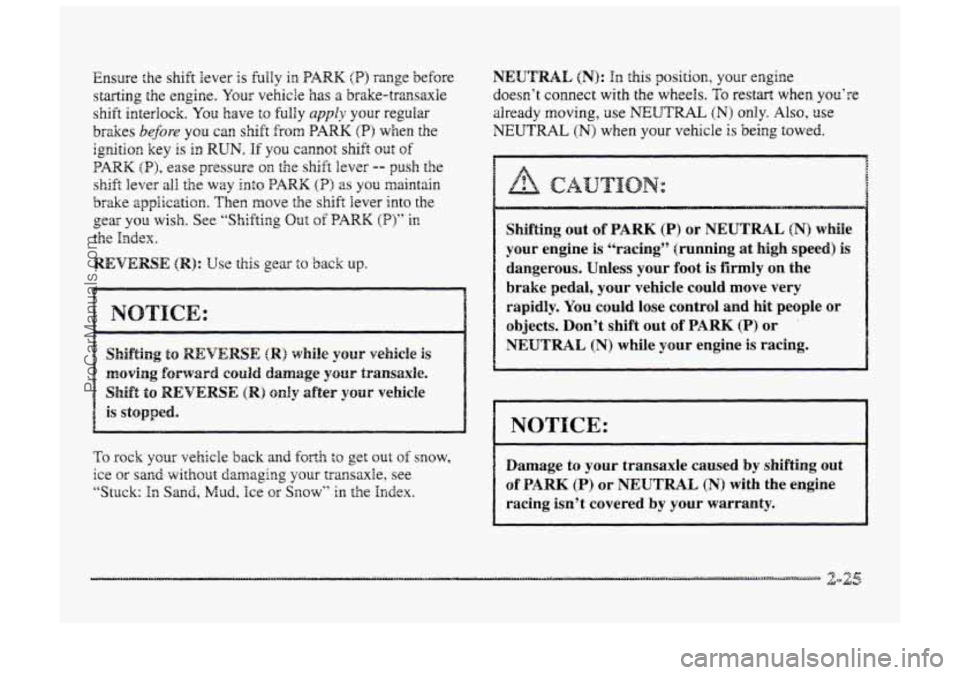
Ensure the shift lever is fuily in PARK (PI range before
starting the engine.
Your vehicle has a brake-transaxle
shift interlock.
You have to fully apply your regular
brzkes
before you can shift from PARK (P) when the
ignition key is in RUN. If you cannot shift out of
PARK (B), ease pressure on the shift lever -- push the
shift lever all the way into PARK (P) as you rnaintain
brake appiic~tion. Then move the shift lever into the
gear you wish. See “Shifting Out of PARK (E’)” in
the Index.
REVERSE (R): Use this gear to back up.
Shift to REVERSE (R) oanhy after vehicle
To rock your vehicle back and forth to get out of snow,
ice sand without damaging your transaxle, see
“Stuck:
In Sand, Mud, Ice or Snow” in the Index.
NEUTRAL (N): In this position, your engim
doesn’t connect with the wheels.
To restart when you’re
already
moving, use NEUTRAL (N) only. Also, use
NEUTRAL (N) when your vehicle is being towed.
Shifting out of PARK (P) or NEUTRAL fN) while
your engine is “racing” (running
at high speed) is
dangerous. Unless your foot is firmly on the
brake pedal, your vehicle could move very
rapidly. You could lose control and hit people
or
objects. Don’t shift out of PARK (P) or
NEUTRAL (N) while your engine is racing.
1 NOTICE:
Damage to your transaxle caused by shifting out
of PARK (P) or NEUTRAL (N) with the engine
racing isn’t covered by your warranty.
ProCarManuals.com
Page 92 of 426
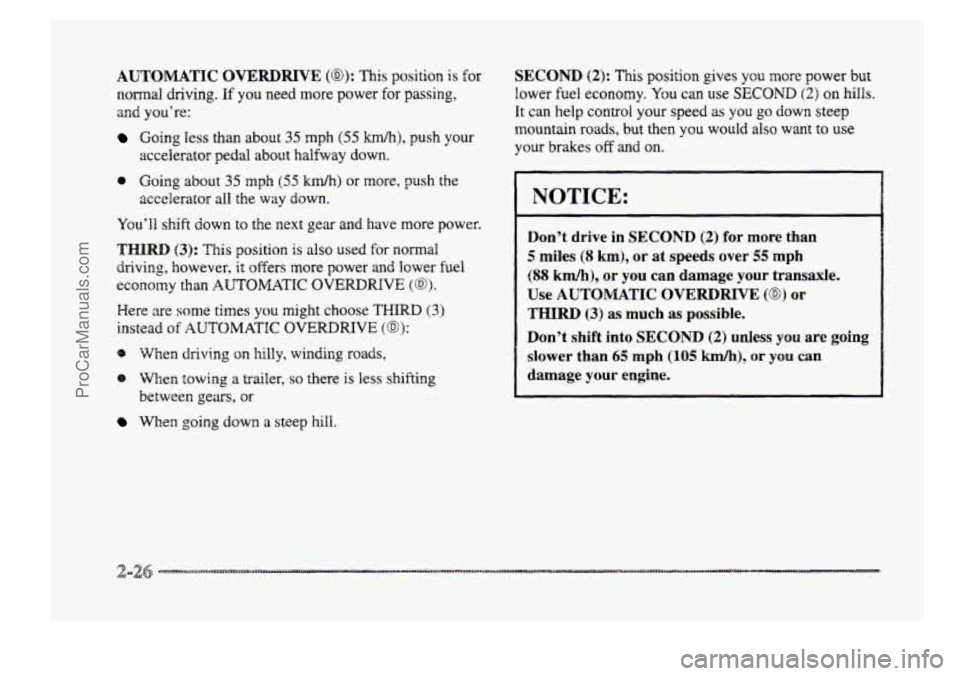
AUTOMATIC OVERDRIVE (@):This positionis for
normal driving. Pf you need more power for passing,
and you’re:
Going less than about 35 mph (55 kmh), push your
accelerator pedal about halfway down.
e Going about 35 mph (55 kmh) or more, push the
accelerator
all the way down.
You’U shift down to the next gear and have more power.
THIRD (3): This position is also used for normal
driving, however, it offers more power and Bower fuel
economy than AUTOMATIC OVERDRIVE (0).
Here are some times you might choose THIRD (3)
instead of AUTOMATIC OVERDRIVE (a):
Qb When towing a trailer, so there is less shifting
between gears,
or
SECQND (2): This position gives you nore power but
lower fuel economy. YQU can use SECOND (2) on hills.
It can help control your speed as you go down steep
mountain roads, but
then you would also want to use
your
brakes off and on.
NOTICE:
Don’t drive in SECOND (2) for more than
5 miles (8 km), or at speeds over 55 mph
(88 km/h), or you can damage your transaxle.
Use AUTOMATIC OVERDRIVE (0) or
THIRD (3) as much as possible.
Don’t shift into SECOND
(2) unless you are going
slower than
65 mph (105 km/h), or you can
damage your engine.
When going down a steep hill.
ProCarManuals.com
Page 93 of 426
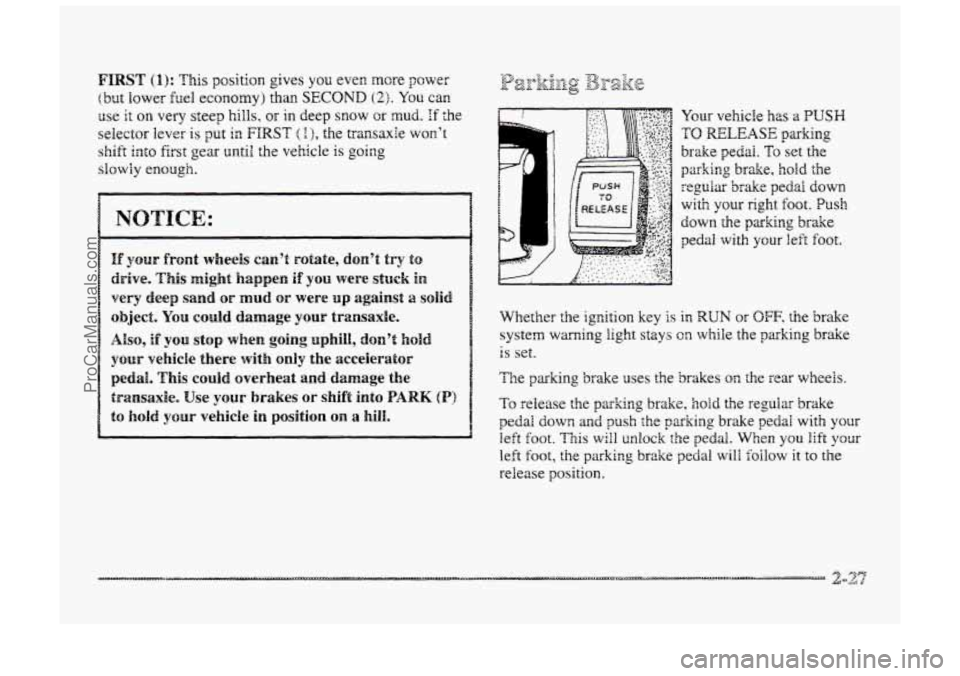
FIRST (I): This position gives you even more power
(but lower fuel economy) than SECOND (2). You can
use it on very steep hills, or in deep snow or mud. If the
selector lever is put in FIRST ( I >, the transaxle won’t
shift into first gear until the vehicle is going
slowHy enough.
If your hplrt wheels can’t rotate, don’t try to
drive. This might happen if YOU were stuck in
very deep sand OF mud or were up against a solid
object. You could damage your transaxle.
Also, if you stop when going uphill, don’t hold
your vehicIe there with only the accelerator
pedal. This could overheat and damage the
transaxle. Use ysur brakes or shift into BARK (P)
Your vehicle has a PUSH
TO RELEASE parking
brake pedai. To set the
parking brake, hold the
regular brake pedal down
with your right foot. Push
down the papking brake
pedal with your left foot.
~~ ~~
Whether the ignition key is in RUN or OFF. the brake
system
wming light stays on while the parking brake
1s set.
The parhng brake uses the brakes the rear wheels.
To release the parking brake, hoki the regular brake
pedal down and push the parking brake pedal with your
left foot. This will unlock the pedal. When you lift your
left foot, the parking brzke pedal will foilow it to the
release position.
ProCarManuals.com
Page 94 of 426
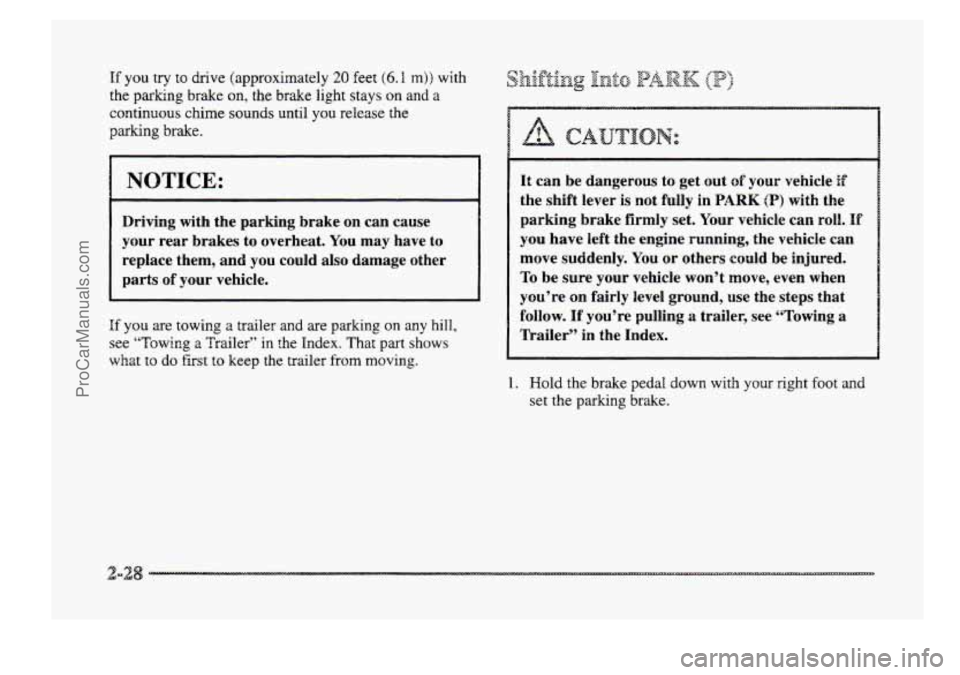
If you try to drive (approximately 20 feet (6.9 m)) with
the
parlkrng brake on, the brake light stays on and a
continuous chime sounds until you release the
parking
brake.
NOTICE:
Driving with the parking brake on can cause
your rear brakes to overheat. You may have to
replace them, and you could also damage other
parts
of your vehicle.
If you are towing a trailer and are parking on any hill,
see “Towing a Trailer” in the Index. That part shows
what
to do first to keep the trailer from moving.
It can be dangerous to get out of your vehicle if
the shift lever is not fully in PARK (P) with the
parking brake firmly set. Your vehicle can roll.
If
you have left the engine running, the vehicle can
move suddenly. You or others
could be injured.
To be sure your vehicle won’t move, even when
you’re on fairly level ground,
use the steps that
follow.
If you’re pulling a trailer, see “Towing a
Trailer” in the Index.
1. Hold the brake pedal down with your right foot and
set the parking brake.
ProCarManuals.com
Page 96 of 426
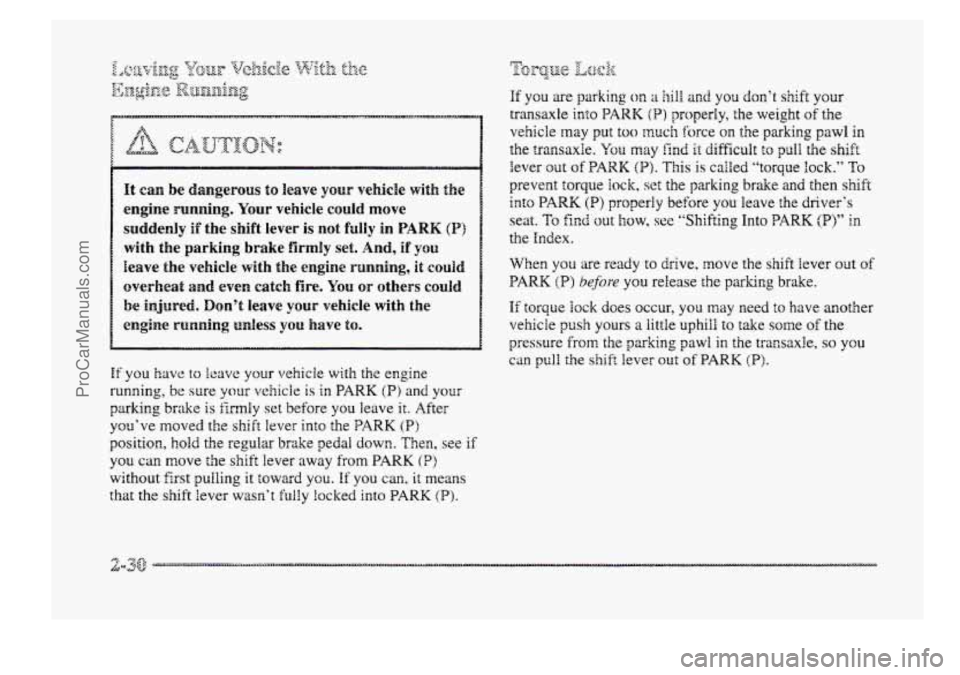
~ It can be dangerous to leave YQW vehicle with the
~ engine running. Your vehicle could move
i suddenly if the
shift lever is not hlPy in PARK (P)
with the parking brake firmly set. And, if you
leave the vehicle with the engine running, it couk.€
overheat and even catch fire. YQU or others could
be injured. Don’t leave YOUK- vehicle with the
engine running unless you have to.
I
Hf you have to leave your vehicle with the engine
running, be sure your vehick is in PARK (P) and your
parking brake is firmly set before you Ieave it. After
you’ve moved the shift lever into the ?ARK (P)
position, hold the regular brake pedal down. Then, see if
YOU can move the shift lever away from PARK (?)
without first pulling it toward you. If you can, it means
that the shift lever wasn’t fully locked into PARK (P).
r-m naqae Le!#& I
If you are parking on ;I hill and you don’t shift your
transaxle into PAKM (P) properly, the weight of the
vehicle may put too rntich force OD the parking pawl in
the transaxle. You may f’ind it difficult to pull the shift
lever out of PARK (P). This is called “torque lock.” To
prevent torque lock, set the parking brake and then shift
into PARK (P) pr~perfy before you leave the driver’s
seat.
TQ find out how, see “Shifting Into PARK (P)” in
the Index.
When you are ready to drive, move the shift lever out of
PARK (P) bejbre YOU retease the parking brake.
If torque lock does occur, you may need to have another
vehicle
push yours a little uphill to take some of the
pressure from the pxking pawl in the tramaxle, so you
can pull, the shiR lever out of PARK (P).
ProCarManuals.com